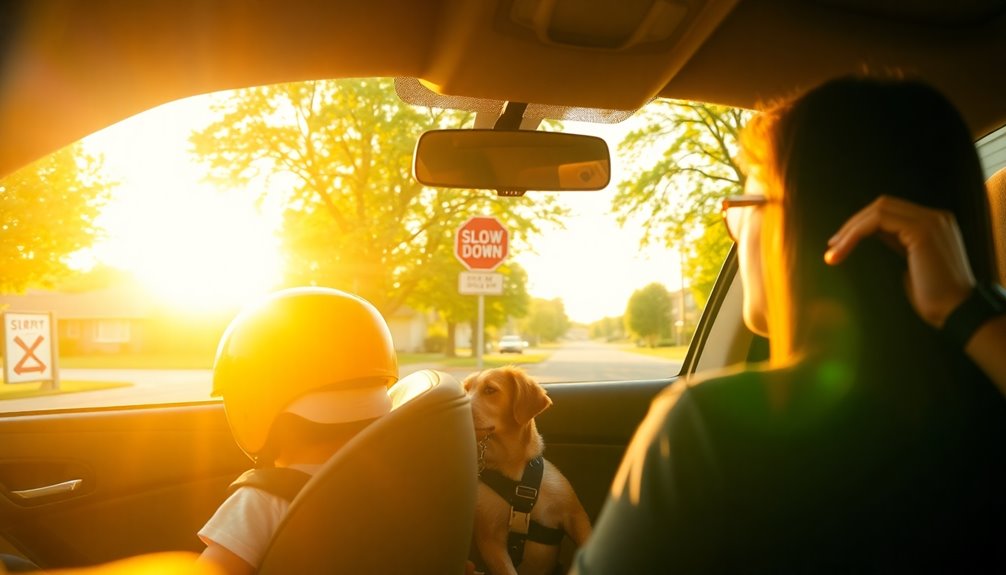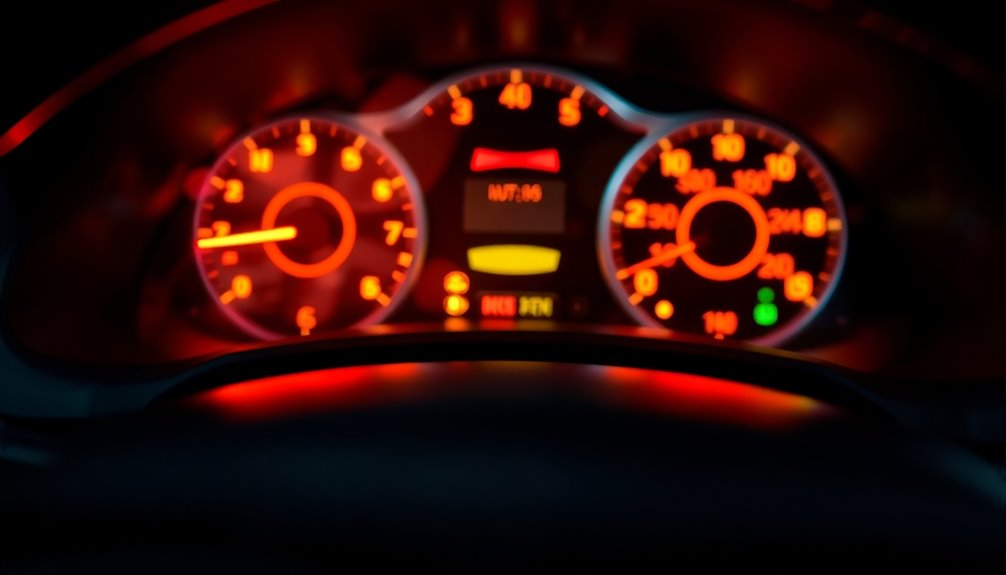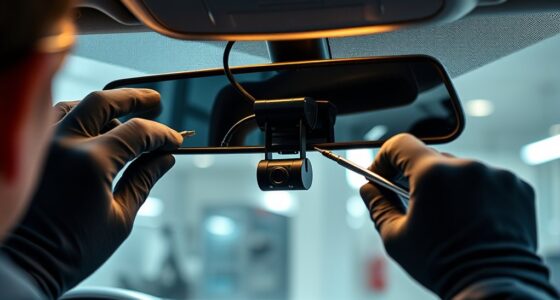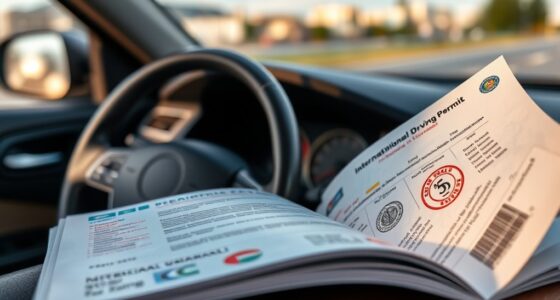To stay safe on the road, it's essential to prepare for your journey by packing an emergency kit and informing someone about your plans. Regular vehicle maintenance is key—check fluid levels, tire pressure, and dashboard alerts. Stay alert while driving by managing distractions and taking breaks every two hours. Finally, keep personal information secure and avoid sharing travel plans publicly. There's more to learn about specific practices that can enhance your road safety.
Key Takeaways
- Always conduct thorough vehicle maintenance, including checking tire pressure and fluid levels, to prevent breakdowns and enhance safety.
- Pack an emergency kit with essentials like snacks, water, and a First Aid kit to prepare for unexpected situations.
- Stay alert while driving by avoiding distractions, taking regular breaks, and limiting passenger interactions to maintain focus.
- Choose secure parking areas that are well-lit and monitored, and keep personal items out of sight to deter theft.
- Familiarize yourself with dashboard alerts and unusual smells to quickly address potential vehicle issues before they escalate.
Preparing for Your Journey

Before you hit the road, it’s crucial to prepare thoroughly so you can stay safe during your journey. Check your vehicle to ensure it’s in good working condition, including the brakes, tires, and lights. Additionally, familiarize yourself with road trip safety tips you need, such as keeping a first aid kit handy and planning your route to avoid unexpected detours. By taking these precautions, you can enjoy a more relaxed and enjoyable travel experience.
Start by packing a Disaster Supplies Kit in your trunk, including high-protein snacks, water, a First Aid kit, and a flashlight. These safety tips to help you in emergencies can make a big difference.
Inform a family member or friend about your destination, route, and expected arrival time, so they know where you are. It's also smart to research potential disasters at your travel destination and familiarize yourself with local emergency sources.
Regularly check weather forecasts leading up to your trip to avoid storms. Additionally, ensure that you have a good understanding of local emergency sources that can provide assistance in case of unforeseen circumstances.
Finally, verify your vehicle is in good condition by checking fluid levels, tire pressure, and lights.
Essential Vehicle Maintenance

Maintaining your vehicle is essential for guaranteeing your safety on the road.
By keeping up with essential vehicle maintenance, you can enhance your driving experience and reduce the risk of accidents.
Here are some key maintenance tasks to prioritize:
- Regularly check and maintain tire pressure to prevent blowouts.
- Inspect brake pads and rotors for wear to guarantee effective stopping distances.
- Monitor fluid levels—engine oil, coolant, and brake fluid—for peak performance.
- Replace windshield wipers every six to twelve months for clear visibility.
Staying Alert While Driving

Staying alert while driving is vital for your safety and the safety of others on the road.
You need to maintain your focus by avoiding distractions like your phone and taking regular breaks to refresh yourself.
Maintain Focus and Concentration
While driving, it's vital to keep your focus sharp to navigate safely and prevent accidents. Staying alert is important, as distracted driving can lead to serious consequences.
Regularly scanning the road and your mirrors helps maintain concentration and anticipate potential hazards. Here are some tips to enhance your focus:
- Avoid using your mobile phone for calls or texts while driving.
- Pull over to a safe location to check messages or make calls.
- Monitor your speed and adjust to road signs consistently.
- Take a moment to stretch and refresh if you feel drowsy.
Take Regular Breaks
Driving requires your full attention, but even the most focused drivers can benefit from taking regular breaks. Aim to stop every two hours during long drives; this helps prevent drowsiness and keeps you alert, considerably reducing the risk of fatigue-related accidents.
Taking a moment to stretch and refresh is essential, as prolonged sitting can lead to poor circulation and increased fatigue. Research shows that even short breaks can improve your reaction times and cognitive function, making it easier to respond to road hazards.
Designating rest areas or truck stops for breaks offers a safe environment to relax. Plus, frequent breaks allow passengers, especially children, to release energy, reducing restlessness and contributing to a more enjoyable trip.
Avoid Distractions While Driving
Because distractions can occur in an instant, it's crucial to keep your focus sharp when you're behind the wheel.
Distracted driving is a leading cause of accidents, resulting in over 390,000 injuries annually in the U.S. To avoid distractions, make a conscious effort to minimize temptations.
Here are some tips to help you stay alert:
- Put your cell phone away while driving.
- Eat before you hit the road to prevent spills.
- Set your navigation system before you start driving.
- Limit the number of passengers to reduce conversation distractions.
Safe Driving Practices With Children and Pets

Ensuring the safety of your children and pets on the road requires careful planning and attention. Always secure your children in appropriate car seats based on their age, weight, and height, and make sure to follow the manufacturer's instructions for proper installation.
Activate child locks to prevent kids from opening doors or windows while the vehicle is in motion. For pets, use a restraint system like a harness or crate to keep them safe and minimize distractions.
Never leave pets unattended in a vehicle, particularly in extreme temperatures, as interior heat can become dangerous quickly.
Finally, maintain a safe distance from other vehicles and clear the floor of loose items to enhance travel safety and reduce hazards during sudden stops.
Managing Distractions on the Road

Managing distractions on the road is essential for your safety and that of others.
By setting phone usage restrictions, limiting passenger interactions, and planning your route before you start driving, you can greatly reduce risks.
Staying focused means you'll be better prepared to react to any situation that arises.
Phone Usage Restrictions
While driving, you mightn't realize how much your phone can distract you, but the statistics speak volumes. Distracted driving, especially from mobile phone use, causes about 9% of fatal crashes each year.
Texting increases your crash risk by 23 times, and using a handheld phone can slow your reaction times by 50%. Many states have laws against handheld phone use, and penalties can include fines or points on your license.
To enhance your safety, consider these tips:
- Use hands-free devices when necessary.
- Silence notifications to avoid distractions.
- Pull over safely if you need to make a call or send a message.
- Set your GPS before hitting the road.
Limit Passenger Interactions
To stay focused on the road, it's crucial to limit passenger interactions that can divert your attention. Start by reducing the number of passengers in your vehicle; more people can lead to increased distractions.
Establish ground rules for behavior, like avoiding loud conversations or distracting games while you drive. Encourage your passengers to assist with navigation and traffic monitoring instead. This way, they help you stay aware of your surroundings rather than create distractions.
Be mindful of how their sudden movements or loud noises can take your focus away, potentially leading to accidents. Remind them that their safety is your priority, and they should remain calm and quiet, especially during high-stress situations.
Pre-Drive Planning Tips
How can you set yourself up for a distraction-free drive? Effective pre-drive planning tips are essential for a safe road trip.
Start by mapping out your route and setting your navigation system before you hit the road. This way, you won't be tempted to adjust it while driving.
Consider these strategies:
- Prepare snacks and drinks in advance to avoid spills.
- Designate a passenger to manage phone calls and messages.
- Silence or put away your mobile phone to avoid notifications.
- Schedule regular breaks during long trips to stay alert.
Understanding Dashboard Signals and Smell Indicators

Understanding your vehicle's dashboard signals and the smells it emits can greatly enhance your safety on the road. Familiarize yourself with the up to 64 different dashboard alerts, as each one can indicate specific car trouble, like engine issues or low oil levels.
Regularly monitor these alerts and consult your vehicle manual to decode any unfamiliar symbols; this guarantees timely maintenance and helps prevent serious problems.
Additionally, pay attention to unusual smells while driving. For example, a burnt carpet smell might signal brake issues, while a hot oil odor could indicate overflow problems.
Recognizing a rotten egg smell suggests a catalytic converter fault, which needs prompt investigation to avoid further damage and keep your vehicle running smoothly.
Importance of Regular Breaks During Long Drives

While commencing on a long drive, taking regular breaks is essential for maintaining your safety and well-being on the road. Stopping every two hours can greatly reduce the risk of drowsy driving, which can impair your reaction times.
These breaks not only enhance circulation but also boost mental alertness, leading to better driving performance.
Consider the following benefits of regular breaks:
- Reduces the risk of fatigue-related errors
- Provides opportunities to stretch and refresh
- Allows you to refuel with food and hydration
- Helps manage stress and energy levels for all passengers
Keeping Your Vehicle and Personal Information Secure

To keep your vehicle and personal information secure, it's important to adopt proactive measures that deter theft and protect your privacy.
Always lock your car doors and windows when parked, and choose secure parking areas with good lighting and surveillance cameras.
Avoid displaying family stickers or personal information on your vehicle that could reveal details about your life.
Keep your vehicle registration and insurance information hidden inside the car to prevent identity theft.
Remember to limit social media posts about your travel plans to trusted friends and family, reducing the risk of burglary while you're away.
Finally, consider having roadside assistance to guarantee you're prepared for any unexpected situations without compromising your security.
Frequently Asked Questions
How to Be Safe While on the Road?
To be safe while on the road, always buckle your seatbelt; it greatly lowers the risk of injury.
Maintain a three-second gap from the car ahead, giving you enough time to react if needed.
Keep distractions at bay—put your phone down and focus on driving.
Regularly check your vehicle's maintenance to avoid breakdowns, and let someone know your travel plans for added safety.
These steps can make a big difference in protecting you.
What Is a Guide to Cross the Road Safely?
Imagine you're a superhero, ready to leap across bustling streets! To cross safely, always look both ways first.
Use marked crosswalks for better visibility, and wait for the green pedestrian signal before crossing.
Stay alert—put away your phone and focus on your surroundings.
When you see cars, make eye contact with drivers to guarantee they notice you.
How Do You Keep Drive Safe on the Road?
To drive safely on the road, always buckle up—it's your best defense against injuries.
Keep a safe distance from the car ahead using the three-second rule, especially in bad weather.
Avoid distractions by putting your phone away and planning your stops ahead.
Regularly check your vehicle's maintenance, like brakes and tire pressure.
Finally, obey speed limits and adjust your speed based on road conditions to maintain control and reaction time.
How Do You Say "Stay Safe on the Road"?
You say "stay safe on the road" by translating it to "mantente seguro en la carretera" in Spanish.
This phrase emphasizes the importance of being proactive while driving. By using it, you're promoting practices like wearing seatbelts and obeying speed limits, which are essential for safety.
Conclusion
Staying safe on the road is like steering a ship through stormy seas; preparation and vigilance are your anchors. By maintaining your vehicle, staying alert, and managing distractions, you can steer clear of potential hazards. Remember to take breaks and keep both your vehicle and personal information secure. With these tips, you'll not only protect yourself and your loved ones but also guarantee a smoother journey ahead, making every trip a safer adventure.









